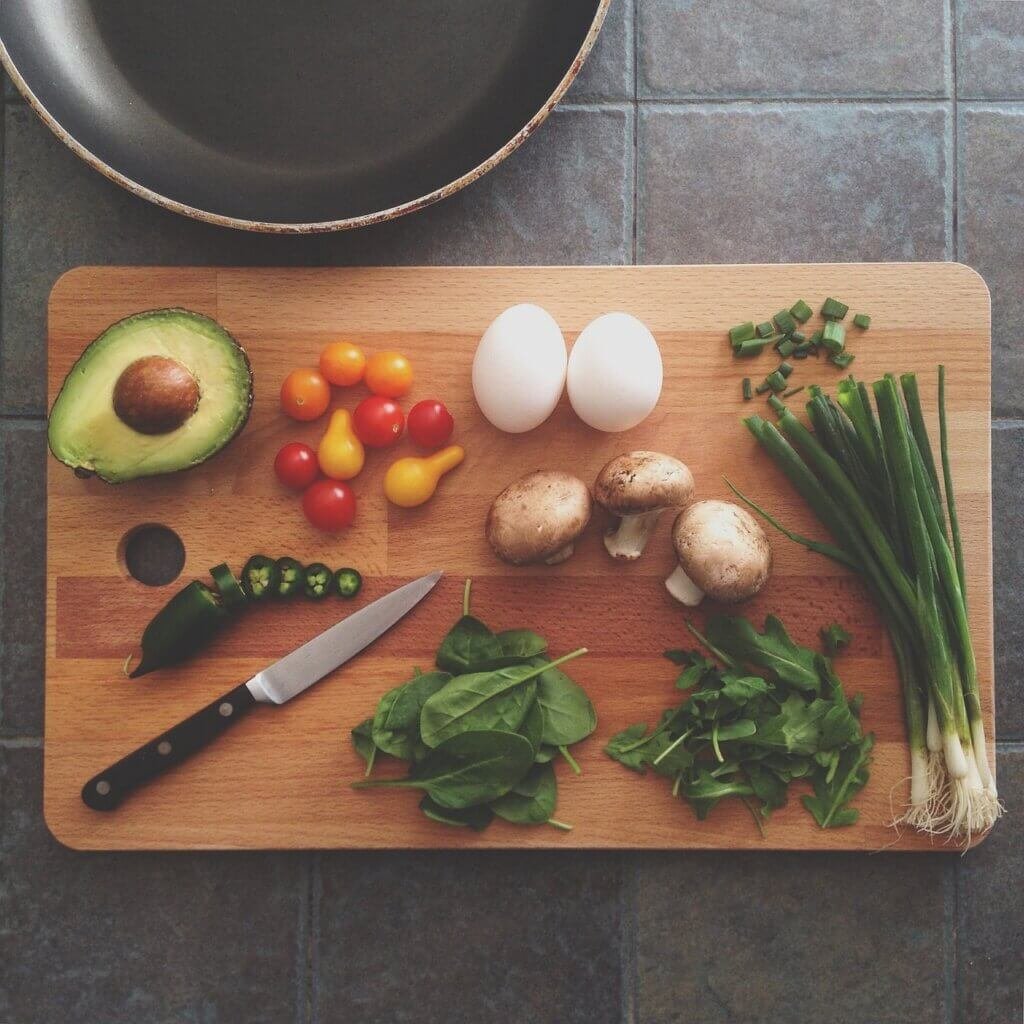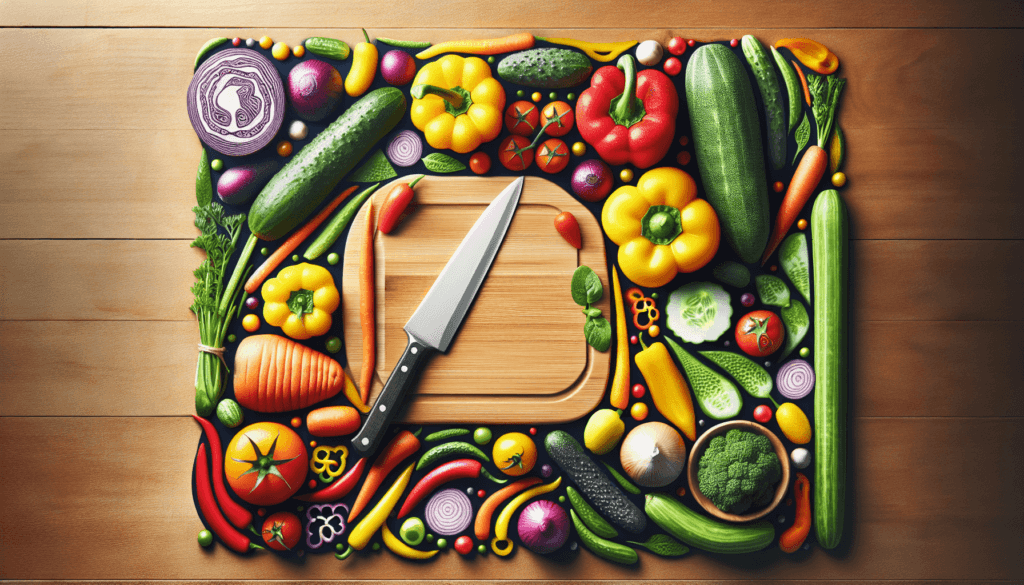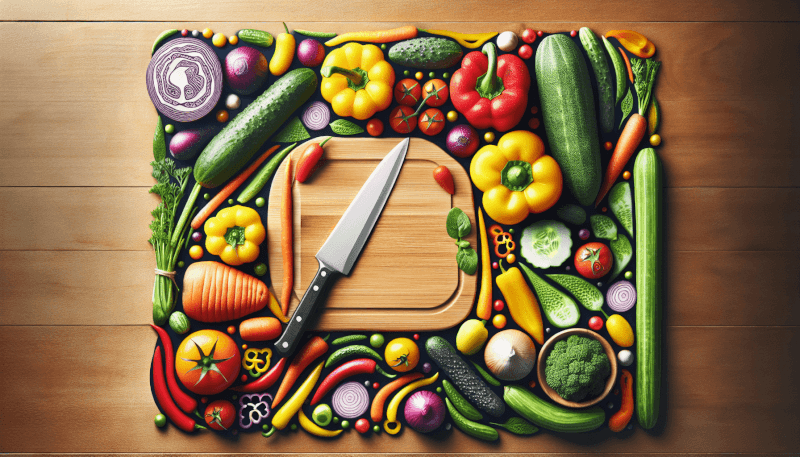If you’re just starting out in the kitchen and feeling a bit overwhelmed, don’t worry – we’ve got you covered! In this article, we’re going to share with you twelve essential cooking hacks that every beginner should know. From expertly peeling garlic to saving overcooked pasta, these simple tips and tricks will help you navigate your way around the kitchen with confidence. So grab your apron and get ready to impress your friends and family with your newfound culinary skills!

Proper Knife Skills
Choosing the right knife
One of the most important aspects of proper knife skills is selecting the right knife for the job. Knives come in various shapes and sizes, each designed for specific cutting tasks. For example, a chef’s knife is versatile and can handle a wide range of cutting, chopping, and slicing tasks, making it a great all-purpose knife for everyday cooking. On the other hand, a paring knife with its smaller and more narrow blade is perfect for intricate tasks like peeling fruits and vegetables or trimming meat. By understanding the purpose of different types of knives, you can ensure you have the appropriate tool for the job and achieve more precise and efficient cuts.
Holding the knife correctly
To maximize control and maintain safety while cutting, it’s crucial to hold the knife correctly. Grip the handle firmly with your dominant hand, placing your thumb on one side of the blade near the base and your index and middle fingers on the other side. Wrap your remaining fingers around the handle for added stability. Your non-dominant hand should be used to steady the food you’re cutting, with your fingers curled inward to protect them from the blade. By maintaining a proper grip, you’ll have better control over the knife and reduce the risk of accidents.
Mastering basic cutting techniques
Learning and practicing basic cutting techniques will enhance both your cooking skills and the presentation of your dishes. Three fundamental cutting techniques are essential for any beginner cook: the slice, the chop, and the julienne. The slice involves cutting through a food item in a smooth, continuous motion, producing even slices of equal thickness. The chop involves a downward motion, cutting through ingredients into small, irregular pieces. The julienne technique creates thin, matchstick-like strips by cutting the food item into long, thin rectangles before slicing into strips. Mastering these techniques will allow you to achieve consistent and appealing cuts, boosting the overall quality of your meals.
Time-Saving Kitchen Gadgets
Instant pot
The instant pot is a versatile and time-saving kitchen gadget that every beginner cook should consider adding to their culinary arsenal. It combines the functions of a pressure cooker, slow cooker, rice cooker, and more in one convenient appliance. The instant pot significantly reduces cooking time, making it perfect for busy individuals looking to prepare delicious meals quickly. With its programmable features, you can easily cook a variety of dishes with just the push of a button. From tender and flavorful stews to perfectly cooked grains, the instant pot will revolutionize your cooking experience and open up a world of possibilities in the kitchen.
Food processor
A food processor is a must-have kitchen gadget for any beginner cook seeking to save time and effort in meal preparation. It simplifies tasks such as chopping, shredding, and mixing ingredients, making them faster and more efficient. Whether you’re making a batch of homemade salsa, finely chopping nuts, or blending ingredients for a creamy sauce, a food processor can handle it all with ease. Its powerful motor and sharp blades ensure consistent results, providing you with more time to focus on other aspects of your cooking. Investing in a food processor will undoubtedly elevate your culinary skills and streamline your cooking process.
Immersion blender
An immersion blender, also known as a hand blender or stick blender, is a valuable tool for any beginner cook who wants to create smooth and creamy textures without the hassle of transferring ingredients to a traditional blender. This handheld gadget is compact, easy to use, and offers excellent control. With an immersion blender, you can effortlessly puree soups, sauces, and even make homemade mayonnaise directly in the container you’re cooking in. Its versatility and convenience make it an essential companion for any aspiring chef, saving you time and effort while achieving professional-quality results.
Understanding Cooking Temperatures
Knowing the different heat levels
Understanding and controlling cooking temperatures is essential for achieving the desired results in your dishes. Different heat levels have specific functions and impacts on the ingredients being cooked. Low heat is generally used for gentle cooking techniques like simmering and poaching, allowing flavors to meld and develop over time without intense heat. Medium heat is ideal for sautéing and stir-frying, offering a balance between browning and cooking food evenly. High heat is perfect for quick cooking methods like searing and boiling, providing rapid and intense heat for browning and caramelization. By knowing the appropriate heat levels for different cooking techniques, you’ll have greater control over your dishes and optimize their flavors and textures.
Using a food thermometer
Using a food thermometer is crucial for ensuring food safety and doneness. It allows you to accurately measure the internal temperature of various foods, ensuring they are cooked to the proper temperature to kill harmful bacteria and achieve optimal taste and texture. Different types of food have different internal temperature requirements to be considered safe for consumption. For example, chicken should be cooked to an internal temperature of 165°F (74°C), while medium-rare steak should reach approximately 135°F (57°C). By utilizing a food thermometer, you can eliminate the guesswork and cook your ingredients with confidence, promoting both safety and culinary success.
Preheating the oven
Preheating the oven is a step that should not be overlooked when cooking or baking. Many recipes require a specific oven temperature to achieve the desired outcome, and preheating ensures that the oven reaches that temperature before you start cooking. Preheating plays a critical role in the overall cooking process, ensuring even cooking and reliable results. It allows ingredients to cook properly from the moment they are placed in the oven, promoting optimal texture and flavor development. By following the recipe’s instructions regarding preheating, you can set the stage for successful and delicious culinary creations.
Culinary Substitutions
Swapping ingredients in recipes
Knowing how to swap ingredients in recipes can be incredibly useful, especially when you find yourself lacking a particular ingredient. While some ingredients are unique and cannot be directly substituted, many others have suitable alternatives that can be used without compromising the flavor or texture of the dish. For example, if a recipe calls for buttermilk, you can easily make a substitute by combining milk with lemon juice or vinegar. Similarly, mashed bananas can be used as a substitute for eggs in some baking recipes. By familiarizing yourself with common ingredient substitutions, you can overcome unexpected ingredient shortages and continue creating delicious meals.
Replacing eggs in baking
For individuals with dietary restrictions or allergies, finding suitable replacements for eggs in baking can be a game-changer. Eggs serve several purposes in baking, including providing moisture, binding ingredients, and leavening. However, there are various alternatives that can be used to achieve similar results. For moisture, ingredients like applesauce, mashed bananas, or yogurt can be used. To replicate the binding properties of eggs, ingredients like ground flaxseed mixed with water or pureed silken tofu can be effective substitutes. Baking powder or baking soda can provide the leavening properties typically associated with eggs. By exploring these egg replacements, you can accommodate a broader range of dietary needs while still enjoying flavorful and perfectly baked treats.
Using substitutes for common allergens
In addition to eggs, there are several common allergens that often need to be substituted in recipes to cater to different dietary requirements or allergies. Wheat flour, for example, can be replaced with alternative flours like almond flour, coconut flour, or gluten-free flour blends. Dairy products, such as milk and butter, can often be replaced with non-dairy alternatives like almond milk and vegan butter. These substitutions allow individuals with dietary restrictions or allergies to still enjoy a wide variety of dishes without compromising taste or quality. By embracing these substitutes and exploring recipe modifications, you can create inclusive meals that cater to everyone’s needs.

Preparing Ingredients in Advance
Chopping and storing veggies
Preparing ingredients in advance is a fantastic time-saving technique that can streamline your cooking process and make mealtime more seamless. One of the most common tasks when cooking is chopping vegetables. By dedicating a specific time to chop and store a variety of vegetables, you can significantly reduce meal preparation time during the week. Wash, peel, and dice your vegetables, then store them in airtight containers or resealable bags. This allows you to have prepped ingredients readily available, whether you need them for salads, stir-fries, or soups. Not only does this save time, but it also encourages you to incorporate more fresh vegetables into your meals, leading to healthier eating habits.
Batch-cooking and freezing meals
Another excellent technique for preparing ingredients in advance is batch-cooking and freezing meals. When you have some free time, consider cooking larger portions of your favorite dishes and storing them in individual containers or freezer bags. This allows you to build a personal collection of ready-to-eat meals that can be defrosted and reheated when you’re short on time or simply don’t feel like cooking from scratch. Whether it’s a comforting stew, a flavorful curry, or a hearty casserole, having meals prepared and frozen in advance ensures that you always have a delicious option on hand without the stress of last-minute cooking. It’s a convenient way to maintain a healthy and balanced diet, even on the busiest of days.
Prepping a week’s worth of ingredients
For ultimate convenience, consider prepping a week’s worth of ingredients in advance. Set aside time at the beginning of the week to plan your meals, make a comprehensive shopping list, and prep as many ingredients as possible. This could include marinating proteins, washing and drying salad greens, or cooking grains like rice or quinoa. By having your ingredients prepped and organized, you can significantly reduce the time and effort required to cook meals throughout the week. It also serves as a great way to stay on track with your nutrition goals since you’ll always have healthy options readily available. With a little bit of planning and preparation, you can easily navigate busy weeknights and enjoy delicious homemade meals with ease.
Improvising with Pantry Staples
Creating sauces from basic pantry ingredients
One of the greatest skills a beginner cook can develop is the ability to create delicious sauces from basic pantry ingredients. With a well-stocked pantry, you’ll have an array of flavor-enhancing ingredients at your fingertips. For example, a simple pasta sauce can be created by sautéing minced garlic and onion in olive oil before adding crushed tomatoes, dried herbs like basil and oregano, and a pinch of sugar to balance the acidity. Similarly, a flavorful stir-fry sauce can be made by combining soy sauce, sesame oil, honey, and ginger. By experimenting with the ingredients you have on hand, you can create unique and flavorful sauces that elevate your meals to the next level.
Making homemade dressings
Store-bought dressings can be convenient, but nothing beats the freshness and flavor of homemade dressings. With just a few staple ingredients from your pantry, you can whip up a variety of dressings to complement any salad or dish. A classic vinaigrette can be made by combining olive oil, vinegar (such as balsamic or red wine vinegar), Dijon mustard, and a touch of honey. For a creamy dressing, mix mayonnaise, yogurt, lemon juice, and your choice of herbs and spices. The beauty of homemade dressings is that you can customize them to your taste preferences, adjusting the sweetness or tanginess to suit your palate. By mastering homemade dressings, you’ll be able to add a personal touch to your salads and other dishes with ease.
Using spices to add flavor
Spices are the secret weapon in every cook’s pantry. By harnessing the power of spices, you can transform simple and mundane ingredients into flavorful and exciting dishes. Experimenting with different spice combinations allows you to enhance the taste profile of your meals, infusing them with unique and complex flavors. For example, a blend of cumin, coriander, and paprika can give a Middle Eastern twist to roasted vegetables, while a mixture of cinnamon, nutmeg, and cloves can elevate your desserts and baked goods. Don’t be afraid to get creative and experiment with spices that you may not be familiar with. With time, you’ll develop a repertoire of spice combinations that will take your cooking to new heights.

Proper Cooking Techniques
Sauteing and stir-frying
Sauteing and stir-frying are versatile cooking techniques that allow you to quickly cook ingredients while preserving their flavors and textures. Sauteing involves cooking small pieces of food in a hot pan with a small amount of oil or fat. The key is to keep the food moving constantly, allowing it to cook evenly without burning. Stir-frying is similar but typically involves higher heat and a larger pan or wok. By quickly tossing ingredients in a hot pan or wok, you achieve rapid and efficient cooking while maintaining their crispness and vibrant colors. These techniques are perfect for cooking vegetables, proteins, and even noodles, delivering delicious, fast, and healthy meals to your table.
Roasting and broiling
Roasting and broiling are dry-heat cooking techniques that help develop rich flavors and textures in various ingredients. Roasting entails cooking food in the oven at a moderate to high temperature, allowing it to caramelize and develop a deliciously golden exterior while retaining moisture inside. Roasting is perfect for meats, poultry, vegetables, and even fruits. On the other hand, broiling involves exposing the food directly to intense heat from the broiler element in the oven. With broiling, you achieve quick and even browning on the surface, creating a delightful contrast of crispy and tender elements. These techniques are wonderful for creating succulent roasts, crispy vegetables, and beautifully charred dishes with minimal effort.
Boiling and simmering
Boiling and simmering are essential techniques for cooking a wide range of ingredients, from pasta and grains to soups and stews. Boiling refers to heating water until it reaches its highest possible temperature, causing bubbles and producing an intense rolling motion. It’s typically used for pasta, rice, and blanching vegetables. Simmering, on the other hand, involves a gentler heat and a lower temperature, with small bubbles occasionally breaking the surface. Simmering is ideal for slow-cooking soups, stews, and sauces, allowing flavors to meld and ingredients to tenderize over time. By mastering these techniques, you can conquer a variety of recipes and ensure perfectly cooked dishes with consistent results.
Organization and Cleanliness
Setting up a functional kitchen
Setting up a functional kitchen is vital for efficient and enjoyable cooking experiences. Start by organizing your kitchen tools and utensils in a way that makes them easily accessible. Utilize drawer dividers or hanging racks to keep everything neatly organized. Group similar items together, such as baking tools or cutting boards, so that you can easily locate them when needed. Keep frequently used ingredients within arm’s reach, either on the counter or in a dedicated pantry area. By creating a well-organized and efficient workspace, you’ll maximize your productivity and minimize frustrations while cooking.
Keeping ingredients organized
Keeping your ingredients organized is crucial for both speed and accuracy in the kitchen. Take the time to categorize and label your pantry items, grouping them based on their type or usage. This makes it easier to find what you need when you’re in the middle of cooking. Keep an inventory of your fresh ingredients, ensuring you use the oldest ones first to prevent wastage. Storing ingredients properly, such as in airtight containers or zip-top bags, helps maintain their freshness and reduces the risk of spills or cross-contamination. By adopting good organizational habits, you’ll save precious time and effort during meal preparation and have more enjoyable cooking experiences.
Maintaining a clean cooking environment
Maintaining a clean cooking environment is essential for both food safety and ease of cooking. Keep your countertops clean and free from clutter, wiping them down regularly to prevent the buildup of bacteria or food residues. Wash and sanitize cutting boards, knives, and other cooking utensils after each use to minimize the risk of cross-contamination. Dispose of food waste promptly and store perishable items at the appropriate temperature to ensure their freshness. Regularly clean your oven and stovetop to prevent grease buildup and potential fire hazards. Additionally, develop a habit of cleaning as you cook, tackling small tasks like washing utensils or wiping spills as they occur. By prioritizing cleanliness in the kitchen, you’ll create a safe and hygienic environment that enhances your cooking experience.

Avoiding Common Mistakes
Don’t overcrowd the pan
One common mistake many beginners make is overcrowding the pan while cooking. Whether you’re sautéing, stir-frying, or roasting, it’s crucial to give your ingredients enough space to cook evenly. Overcrowding the pan leads to a decrease in temperature, as the heat is unable to distribute and reach every ingredient properly. This results in steamed or soggy food instead of achieving the desired caramelization and browning. The key is to cook in batches if necessary, ensuring there is sufficient space between each piece of food. By giving your ingredients room to breathe, you’ll achieve better results and maintain the delicious flavors and textures of your dishes.
Don’t forget to taste as you cook
A crucial aspect of becoming a skilled cook is developing your palate and learning to adjust flavors as you go. One common mistake is forgetting to taste your dishes throughout the cooking process. By regularly tasting your food, you can make necessary adjustments to seasonings, acidity, sweetness, or spiciness to achieve a well-balanced and flavorful final result. Seasoning should be a gradual process, adding little by little and tasting each time to prevent over-seasoning. Remember that flavors develop and intensify as ingredients cook, so it’s essential to continually evaluate and adapt the flavors to your preferences. By cultivating your tasting skills, you’ll become more confident and intuitive in the kitchen.
Don’t rush the cooking process
Patience is a virtue in the kitchen, and rushing the cooking process can lead to subpar results. Each ingredient requires a certain amount of time to cook properly and develop its unique flavors and textures. Rushing can result in undercooked or unevenly cooked food, compromising both taste and safety. Whether it’s allowing meat to properly rest after cooking or giving sauces and stews time to simmer and thicken, patience is key to achieving excellent results. Follow recipes carefully and resist the urge to increase heat or decrease cooking times, as adjustments should be made based on knowledge and experience. Embrace the process of cooking, savor each step, and enjoy the journey to a delicious meal.
Meal Planning and Batch Cooking
Creating a weekly meal plan
Creating a weekly meal plan is a game-changer for busy individuals looking to eat nutritious and delicious meals every day. Start by dedicating some time each week to plan your meals in advance. Consider your schedule, the ingredients you already have on hand, and any dietary preferences or restrictions. Choose a variety of recipes that include different proteins, whole grains, and a rainbow of fruits and vegetables. Once your meals are planned, make a comprehensive shopping list to ensure you have all the necessary ingredients. Having a meal plan eliminates the decision-making process each day and reduces the likelihood of resorting to unhealthy convenience foods. It also allows you to optimize your grocery shopping and minimize food waste, leading to more efficient and cost-effective meal preparation.
Shopping for ingredients in bulk
When meal planning and batch cooking, shopping for ingredients in bulk can help save time, money, and frequent trips to the grocery store. Identify pantry staples and frequently used items that have a longer shelf life, such as grains, canned goods, and spices, and purchase them in larger quantities. Buying in bulk often comes with a cost savings, making it a budget-friendly option. Additionally, consider purchasing larger portions of meat or poultry and portioning them out for individual meals before freezing. This allows you to take advantage of sales or discounts while ensuring you always have protein on hand. Shopping in bulk not only simplifies the cooking process but also ensures you’re well-stocked for future meals.
Preparing multiple meals at once
Batch cooking is a fantastic strategy to save time and effort in the kitchen while ensuring you have nutritious meals readily available. Set aside a dedicated time, such as a weekend afternoon, to cook and prepare multiple meals at once. Choose recipes that can easily be scaled up, such as casseroles, soups, or one-pot meals. Once prepared, portion the meals into individual containers or freezer bags for easy storage and future consumption. Label each container with the name of the dish and the date prepared to keep track of freshness. By batch cooking, you’ll have a selection of homemade meals at your fingertips, preventing the temptation to rely on takeout or processed convenience foods. It’s a strategy that promotes healthier eating habits and reduces stress during busy weekdays.
In conclusion, mastering the art of cooking is an exciting and rewarding journey. By honing your knife skills, utilizing time-saving kitchen gadgets, understanding cooking temperatures, experimenting with culinary substitutions, preparing ingredients in advance, improvising with pantry staples, practicing proper cooking techniques, prioritizing organization and cleanliness, avoiding common mistakes, and implementing meal planning and batch cooking, you’ll become a more confident and efficient cook. With these tips and techniques, you’ll be well-equipped to create delicious meals and enjoy the joys of cooking for yourself, your family, and your friends. Happy cooking!



